
Catalog excerpts

POST-TENSIONING SYSTEMS MULTISTRAND SYSTEMS BAR SYSTEMS REPAIR AND STRENGTHENING NEW VICTORY BRIDGE, PERTH AMBOY, NJ
Open the catalog to page 1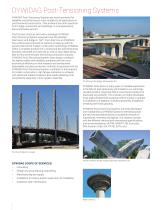
DYWIDAG Post-Tensioning Systems DYWIDAG Post-Tensioning Systems are world renowned for reliability and performance, most suitable for all applications in post-tensioned construction. They embrace the entire spectrum from bridge construction and buildings, to civil applications, above and below ground. The first ever structure built with a prototype DYWIDAG Post-Tensioning System using bars was the Alsleben (Germany) arch-bridge in 1927. From that time on DYWIDAG has continuously improved its systems to keep up with the growing demand of modern construction technology. DYWIDAG offers a...
Open the catalog to page 2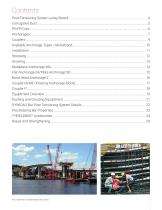
New Highlands-sea Bright Bridge, New Jersey
Open the catalog to page 3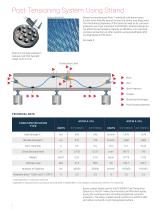
Post-Tensioning System Using Strand Strand is manufactured from 7 individual cold-drawn wires, 6 outer wires helically wound around one center wire (king wire). The mechanical properties of the strand as well as its corrosion protection are most important to DYWIDAG. Strand coatings do not affect the anchorage‘s capacity or efficiency. For improved corrosion protection we offer systems using polyethylene (PE) or polypropylene (PP) ducts. Epoxy coated strand Strand is normally packed in calwrap coils that typically weigh up to 3.2 ton. Construction Joint Vent Grout Injection Coupler...
Open the catalog to page 4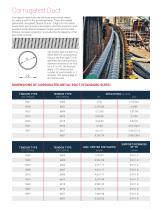
Corrugated Duct Corrugated metal ducts are the most economical means to create a void for the tensile elements. These thin-walled I.D. galvanized corrugated 28ga/0.38 mm - 24ga/0.61 mm sheet metal ducts also provide a secondary corrosion protection with excellent bond behavior between tendon grout and concrete. O.D. Primary corrosion protection is provided by the alkalinity of the grout and concrete. The tendon type number (e.g. 5904, 6807) is composed as follows: the first digit (5 or 6) identifies the nominal strand diameter in tenths of an inch, i.e. 0.5“ or 0.6“, the last two digits...
Open the catalog to page 5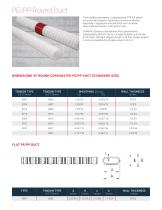
PE/PP Round Duct Thick-walled polyethylene / polypropylene (PPEX3) plastic ducts provide longterm secondary corrosion protection especially in aggressive environments such as waste water treatment plants, acid tanks or silos. DYWIDAG-Systems International offers polyethylene/ polypropylene (PPEX3) ducts in straight lengths up to 80 feet for all sizes. Standard shipping length is 40 feet. Longer lengths in coils are available for all sizes except 130 mm. DIMENSIONS OF ROUND CORRUGATED PE/PP DUCT (STANDARD SIZE) TENDON TYPE SHEATHING (in/mm) WALL THICKNESS FLAT PE/PP DUCT WALL THICKNESS in/mm
Open the catalog to page 6
Anchorages MULTIPLANE ANCHORAGE MA The two-part multiplane anchorage is primarily used for longitudinal tendons in beams and bridges. The wedge plate and compact conical anchor body with three load transfer planes introduces the prestressing force gradually into the concrete member. The separation of anchor body and wedge plate makes it possible to insert the strand after casting the concrete. The wedge plate self-centers on the anchor body providing accurate installation as well as trouble-free stressing. The anchorage is also suitable for cryogenic application (LNG-tanks). The six bolt...
Open the catalog to page 7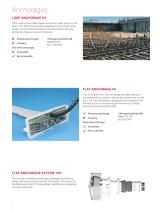
Anchorages LOOP ANCHORAGE HV Often used in large plate-shaped structures, walls, piers or LNG tanks. The 180º loop should be positioned in the center of the tendon to minimize movement of the strand within the loop during simultaneous two-end stressing. Stressing anchorage Coupling Dead end anchorage: Ultimage load [kips/kN] from 82/372 to 1.169/5,301 FLAT ANCHORAGE FA The 3-0.6“ and 4-0.6“ Flat Anchorage provides strands in one plane with a trumpet to deviate the strands into an oval duct. The Flat Anchorage is designed to be installed in thin members such as transverse post-tensioning of...
Open the catalog to page 8
Couplers COUPLER M/ME (FLOATING ANCHORAGE BLOCK) Cylindrical structures (water tanks, digestor tanks, large pipes or dome shells) that require circumferential posttensioning are the principal applications for the floating coupler M/ME. The tendon anchorage consists of an anchorage block with wedge holes on both sides to accept bare or greased and sheathed strands. The strands overlap within the block. The ringtendon is very compact and requires a small pocket. Stressing is performed using conventional jacks and a curved jack nose. pocket former for each anchorage system on request M...
Open the catalog to page 9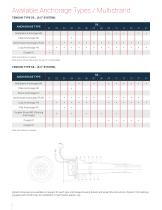
Available Anchorage Types / Multistrand TENDON TYPE 59… (0.5“ SYSTEM) ANCHORAGE TYPE Loop Anchorage HV Coupler D Bond Head Anchorage ZF/ZR Other size tendons on request Plate Anchor SD and Flat Anchor FA use 0.5“ Jumbo Wedge TENDON TYPE 68… (0.6“ SYSTEM) ANCHORAGE TYPE Plate Anchorage SD Mono Anchorage EV Bond Head Anchorage ZF/ZR Flat Anchorage FA Coupler M and ME (Floating Anchorage) Other size tendons on request System drawings are available on r
Open the catalog to page 10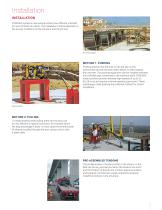
Installation INSTALLATION DYWIDAG-Systems International utilizes two different methods to insert strands into ducts. The installation method depends on the access conditions of the structure and the job site. Uncoiling cages METHOD 1: PUSHING Pushing strands into the duct on the job site is very economical and can be done either before or after casting the concrete. The pushing equipment can be installed remotely and a flexible pipe connected to the insertion point. DYWIDAG strand pushers provide relatively high speeds of up to 25 ft/s (8 m/s) and require minimal operating personnel. These...
Open the catalog to page 11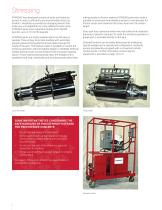
Stressing DYWIDAG has developed a series of jacks and hydraulic pumps in order to efficiently and economically stress its tendons. Versatility is provided by changing devices that make one unit adaptable for many different tendon sizes. DYWIDAG jacks have capacities ranging from 56/250 kips/kN up to 2,191/9,750 kips/kN. DYWIDAG jacks are highly sophisticated, but still easy to operate. They employ inner tube bundles with automatic gripping devices that guide the strand safely through the inside of the jack. This feature makes it possible to control the stressing operation with the highest...
Open the catalog to page 12All DYWIDAG-Systems International (DSI) catalogs and technical brochures
-
STAY CABLE BRIDGE
13 Pages
-
ROCK BOLTING AND MESH
24 Pages
-
ANCHOR SYSTEMS
20 Pages
-
Accessories for Concrete Structures
152 Pages






